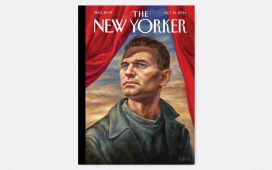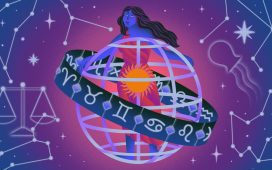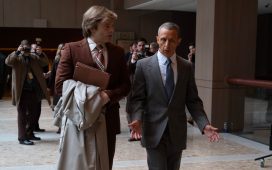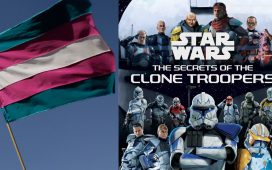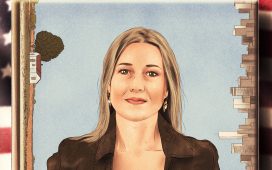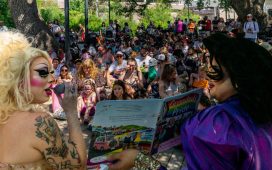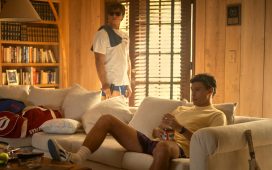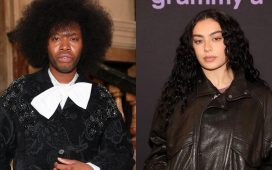In the early weeks of 2008, as Barack Obama was fighting Hillary Clinton for the Democratic Presidential nomination, many Party members felt obliged to pick a side, and to lend their voices to the side they picked. Few of these voices were as powerful as that of John Lewis, a congressman from Georgia and a veteran of the civil-rights movement. Lewis was skeptical of Obama, who was then a first-term senator from Illinois, known less for any particular accomplishment in Washington than for the inspirational speeches he gave. “He is no Martin Luther King, Jr.,” Lewis told the Washington Post, at a time when those speeches were helping Obama eat into Clinton’s once formidable lead in the polls. “I knew Martin Luther King.” King had been Lewis’s mentor, and then his ally; after King’s assassination, Lewis came to be viewed as King’s spiritual and moral heir. But Lewis was also a loyal Democrat, which made him a loyal supporter of the Clintons. “You need more than speech-making,” he said. “You need someone who is prepared to provide bold leadership.”
In “John Lewis: A Life” (Simon & Schuster), an appropriately weighty new biography, the historian David Greenberg explains what happened next. Obama’s poll numbers kept improving, and Lewis’s skepticism began to evaporate. During a conversation with Representative James Clyburn, of South Carolina, Lewis admitted that he was growing concerned about being “on the wrong side of history”; given that Lewis was known, above all, for having been on the right side of history in the nineteen-sixties, this was no small concern. After a few weeks of deliberation, Lewis called the Clintons to warn them that he was going to un-endorse Hillary, and then went on television to proclaim his support for Obama. Later, he explained to Oprah Winfrey that he had come to see Obama’s movement as “very similar to the civil-rights movement,” which meant that he could hardly fail to support it. Lewis later described Obama’s election as a singular triumph—a kind of delayed vindication of all the marches and protests decades earlier. “I jumped so high I started shouting,” he said. “I was just so overcome.”
It was hardly the first moment of vindication for Lewis; nor was it the last. He was only thirty-five when he was beatified, alongside Mother Teresa, in a 1975 Time cover story titled “Saints Among Us.” By the time he died, in 2020, at the age of eighty, he had been celebrated in countless documentaries, television specials, and books, including a graphic-novel trilogy called “March.” Earlier this year, Raymond Arsenault published an admiring biography, “John Lewis: In Search of the Beloved Community.” Greenberg’s book is less hagiographic: it tells the story of Lewis’s life and his career, first in the civil-rights movement, which he understood intuitively, and then in Congress, which took him a little longer to figure out. When he spoke at the March on Washington, in 1963, Lewis had asked, “Where is our party? Where is the political party that will make it unnecessary to march on Washington?” Although he continued to believe in the necessity of marches, he came to see the Democratic Party as his own. Protest and partisanship, he decided, were more compatible than he once thought.
Some biographers must wrestle with their subjects’ inconsistencies, but Greenberg, for the most part, has the opposite challenge: Lewis seems to have been a stubbornly straightforward character, deeply committed to the civil-rights movement, and to other movements and moments that evoked it. His years fighting Jim Crow taught him the importance of courage in the face of injustice, and gave him a story that was sometimes too inspiring to be easily useful. In the second half of his life, he had to contend with the seeming mismatch between the soaring rhetoric of nineteen-sixties activism and the more earthbound reality of everyday politics, which often seemed rather petty or sordid by comparison. (In the context of an election, the courage to stand up for what’s right might mean trying to block the ascent of an intriguing but untested senator from Illinois, at least temporarily.) In the nineteen-eighties, when Lewis was a member of the Atlanta city council, he became involved in an effort to stop the construction of a highway leading to Jimmy Carter’s new Presidential library, arguing that it would disrupt nearby neighborhood life. During what seems to have been a lively forum hosted by the Georgia Department of Transportation, Lewis delivered a characteristically passionate speech, declaring, “We will use nonviolent protest to stop this road!” Powerful forces were arrayed against him, including Carter himself, but Lewis’s opposition was implacable, though not insuperable. After Lewis went to Washington, a modified version of the highway was built, in time for the 1996 Olympics, and in 2018 it was renamed the John Lewis Freedom Parkway. At the naming ceremony, Lewis did not mention his past opposition to the project. Instead, he thanked the city, and encouraged everyone to vote in the forthcoming midterm elections, using his own history to suggest that politics was a simple choice between two directions. “We’ve come too far, we’ve made too much progress, and we’re not going back,” he said. “We’re going forward.”
One of the most astonishing things about Lewis’s life is how quickly he found his path, and how closely he hewed to it. His parents were sharecroppers in rural Alabama, and he was one of ten children; his family appointed him to take care of the chickens, and he appointed himself to stage a peaceful protest whenever it came time for one of them to be slaughtered. In “Walking with the Wind,” his 1998 memoir, Lewis wrote of hearing about “racial incidents” from many of the Black people he knew. (He didn’t know any white ones.) When Emmett Till was abducted and lynched in Mississippi, a few hundred miles away, Lewis was fifteen, just a year older than Till. Around the same time, Lewis heard Martin Luther King, Jr., on an AMradio station broadcasting from Montgomery, and soon resolved to join King’s movement of spiritual and political liberation. “I wanted to use the emotional energy of the Black church to end segregation and gain freedom for Black people,” Lewis later recalled, and, in 1957, as a first step, he decided to enroll at the American Baptist Theological Seminary, in Nashville.
He was not immediately recognized as a future leader. He was shy, with a strong accent and what Greenberg describes as a “mild speech impediment”; one friend remembered him as “pure hick.” And he was never particularly interested in the finer points of academic theology. (He was eventually ordained, and later earned a bachelor’s degree from Fisk, with what sounds like significant help from his friend Archie Allen. “The thesis was very solid, but it needed some editing,” Allen told Greenberg. “Maybe I did the typing, too.”) Lewis was single-minded, though, and before long he met his hero King—the two briefly considered a plan for Lewis to sue to desegregate Troy State, a whites-only institution near his home in Alabama, until Lewis’s parents objected, fearing retaliation. Lewis also met James Lawson, an ally of King’s who had studied Gandhi’s doctrine of nonviolence while working as a missionary in India; by his junior year, Lewis was attending Lawson’s nonviolence workshops and participating in local sit-ins. On a Saturday in February, 1960, during a sit-in at a segregated Woolworth’s, Lewis was punched in the ribs by a counter-protester, and then arrested along with dozens of fellow-students, who refused to pay their bail on principle. From the start, Lewis’s friends and comrades were amazed by his bravery and discipline. A white pastor who was active in the movement marvelled, “I think you could kill him and he wouldn’t resist.” Another activist said, “I never even saw him get angry.” He wasn’t tall, but he was imposing—“granite, fixed, immovable,” another ally recalled, with “lips always pursed.”
In November of 1960, in Nashville, he was locked inside a restaurant and subjected to fumigation; the manager released him only when the fire department showed up. During the Freedom Rides, a travelling protest against segregated bus lines, Lewis was bashed in the head with a wooden crate, knocked briefly unconscious, and left to bleed. Most famous of all was his assault in Selma, Alabama, during the confrontation known as Bloody Sunday, when his skull was fractured by a state trooper’s club and he was reduced to vomiting from tear gas; a few hours later, bandaged and lying in a hospital bed, he told a television news crew about the importance of nonviolent protest. These were not mishaps but crucial elements of the movement’s plan to make America confront its treatment of Black people. Lewis understood, more deeply and vividly than many of his contemporaries, the symbolic power of blood, especially when it was your own. “We have shed too much blood in Mississippi to accept a compromise,” he said at the 1964 Democratic Convention, during a debate over whether the Party would seat a whites-only delegation or an integrated alternative.
Only five years passed between Lewis’s first arrest, in Nashville, and the 1965 march from Selma to Montgomery, which he helped lead alongside King, and which was probably his most famous protest. He was rather monkish in his devotion to the movement—Greenberg describes him as “fiercely moralistic”—although his friends sometimes helped him broaden his horizons. (Greenberg recounts a trip to Zambia, during which Lewis and other activists were taken to a night club featuring some sort of striptease. “I had not seen similar entertainment in the U.S.,” Lewis remarked.) Some allies viewed Lewis’s steadfastness as faintly embarrassing. Andrew Young, another activist who later became a politician, once recalled seeing Lewis and his acolytes on a college campus, neatly dressed for yet another sit-in. Young asked a student what was going on. “That’s John Lewis’s group,” the student said. “There are a couple of restaurants that still haven’t desegregated.” After Lewis spoke at the March on Washington, one of his allies reportedly said, “Wow, this is the first time I’ve seen John without a bandage on his head.”
At the time of the March on Washington, in August, 1963, Lewis had just been elected chairman of the Student Nonviolent Coordinating Committee, known as SNCC (pronounced “snick”), which was younger and more militant than King’s group, the Southern Christian Leadership Conference. Part of Lewis’s job as chairman was to figure out how much more militant it should become. The divide was evident at the march, where Lewis originally planned to give a speech that evoked William Tecumseh Sherman, the Union general who cut a devastating swath through Georgia during the Civil War. “We shall pursue our own ‘scorched earth’ policy and burn Jim Crow to the ground,” Lewis was going to say, before landing on a significant adverb: “nonviolently!” King himself intervened, asking Lewis to tone it down, and Lewis agreed, perhaps because his fiery draft was itself an attempt to find a compromise between different voices within SNCC, some of which were notably more radical than his.
At a time when so much activism is decentralized, it is illuminating to remember the extent to which the civil-rights movement was driven by membership organizations. In the years after the march, SNCC became a natural home for activists who were put off by King’s piety and relative moderation. (Some people referred to him, derisively, as De Lawd.) Meanwhile, Lewis had to contend with younger allies who viewed nonviolent resistance as a kind of masochism, and who increasingly gravitated toward an incendiary slogan with no clear definition: “Black Power!” These frustrations erupted during a fateful SNCC retreat in 1966, in a town outside Nashville called Kingston Springs. The movement was in a paradoxical position: the more progress it made—Congress had passed the Civil Rights Act of 1964, and then the Voting Rights Act of 1965—the less momentum there seemed to be. It had been scarcely a year since Bloody Sunday, and yet many younger activists had come to see Lewis as ineffective, or worse. One of his fiercest critics within SNCC was a lifelong activist named Fay Bellamy, who later recalled that she saw Lewis as “a bit of a handkerchief head,” adding, “Every time L.B.J. called, he’d rush his clothes into the cleaners and be on the next plane to Washington.” This complaint—that sncc’s leader conferred too often with the President of the United States—says something about both the power and the fractiousness of the group at its height.
The man who became Lewis’s chief rival was in many ways his opposite: Stokely Carmichael, an erudite and provocative exponent of Black Power. In his memoir, Lewis recalled that Carmichael “loved nothing more than to scare the hell out of people, especially white people.” Carmichael, for his part, remembered Lewis as “a regular guy, uncomplicated, friendly, and brave,” which was part of the problem. Carmichael became the consensus choice of a SNCC faction that was looking for a chairman who would be a bit less regular, and a lot less friendly. (One member said, “We need someone to tell Martin Luther King to go to hell.”) During the Kingston Springs retreat, Lewis was reëlected chairman, by a vote of sixty to twenty-two. Then an activist named Worth Long challenged the election on procedural grounds; in fact, there didn’t seem to have been any problem with the procedure, but Long’s challenge helped unleash a rowdy late-night debate. In the course of it, nearly everyone seemed to agree that there was a problem with Lewis, and he was subjected to a series of heated denunciations. In his memoir, Lewis described the meeting as a kind of apocalypse:
Finally, sometime around dawn, Carmichael was elected the new chairman of SNCC, reorienting the group and effectively ending Lewis’s career as a professional civil-rights activist. Even in Greenberg’s careful account, the precise nature of the dispute remains obscure. The headline in the New York Times read, “MILITANTS TAKE OVER STUDENT COORDINATING GROUP,” and the accompanying story emphasized Carmichael’s disdain for both the Democrats and the Republicans. (“To ask Negroes to get in the Democratic Party is like asking Jews to join the Nazi Party,” Carmichael said.) A follow-up article suggested that one of Carmichael’s initiatives was to make SNCC a fully Black group. “We will not fire any of our white organizers,” he told the Times, “but if they want to organize, they can organize white people. Negroes will organize the Negroes.” Carmichael later argued that the media made too much of this shift, saying that “SNCC had always been a black-led organization.” But his move to sideline the group’s white members made Lewis and his allies seem like a bunch of old-fashioned integrationists, too concerned with what white folks wanted—and therefore not concerned enough with what Black folks needed.
